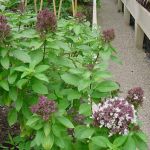| Common Name: |
Culantro |
| Other Names: |
Fitweed, perennial coriander, chandon benni, shadow bennie |
| Botanical Name: |
Eryngium foetidum syn E. antihystericum |
| Genus: |
Eryngium |
| Family: |
Apiaceae |
| Native Location: |
Seasonally dry grassland in the West Indies, C America, and Florida |
| Cultivation: |
Damp, heavy soil in sun or shade with ample warmth and humidity all year (E. foetidum); well-drained, sandy or stony soil in sun (E. maritimum). |
| Propagation: |
By seed sown when ripe; by root cuttings in late winter. Seeds of E. maritimum are sown in spring after stratifying for 4 weeks. |
| Harvest: |
Leaves (E. foetidum) are picked before flowering; roots of second-year plants are lifted in autumn and used fresh for flavoring, and fresh or dried for infusions and decoctions. Roots of E. maritimum are lifted in autumn and used fresh for conserve, or dried for use in powders, decoctions, and flavorings. |
| Height: |
60cm (24in) |
| Width: |
60cm (24in) |
| Hardiness: |
Min. 15-18°C (59-64°F) |
| Parts Used: |
Leaves, roots |
| Properties: |
A pungent, aromatic herb that lowers fever, relaxes spasms, and benefits the digestion. |
| Medicinal Uses: |
Internally, in Carib medicine, as a cure-all and, specifically, for epilepsy, high blood pressure, and fevers, fits, and chills in children. |
| Culinary Uses: |
Leaves and roots are important in Latin American and SE Asia in soups, curries, and rice and fish dishes. An ingredient of sofrito, a seasoning mix that also includes coriander/cilantro and chilis (usually ajicitos, small bonnet peppers from Capsicum chinense, See, capsicum chinense). |
| Bibliography: |
Encylopedia of Herbs by Deni Brown Copyright ©: 1995, 2001 Dorling Kindersley Limited pp 204-205
|

